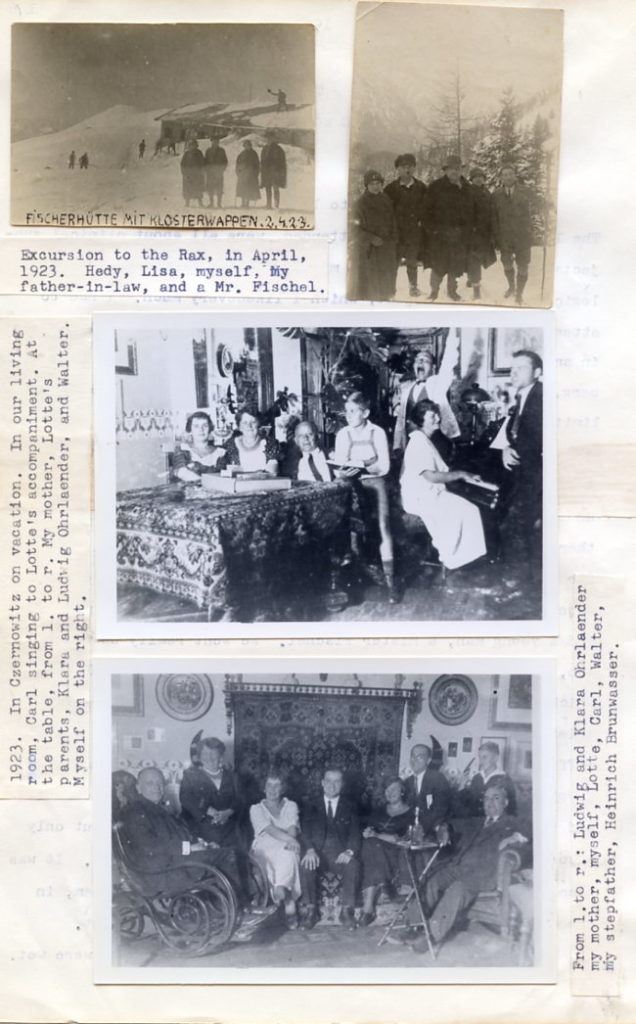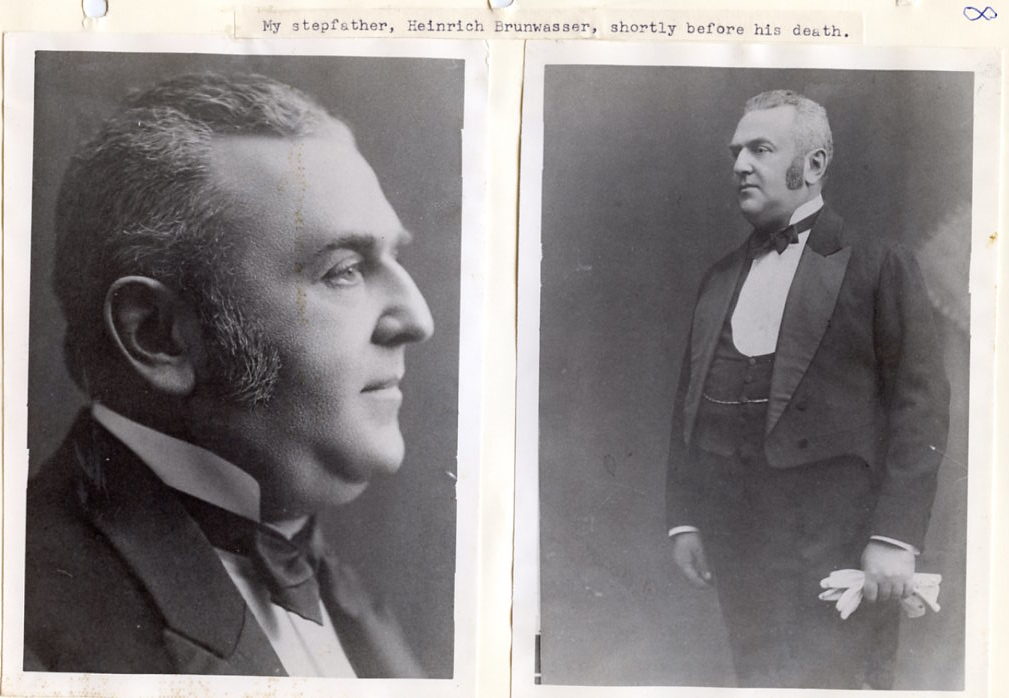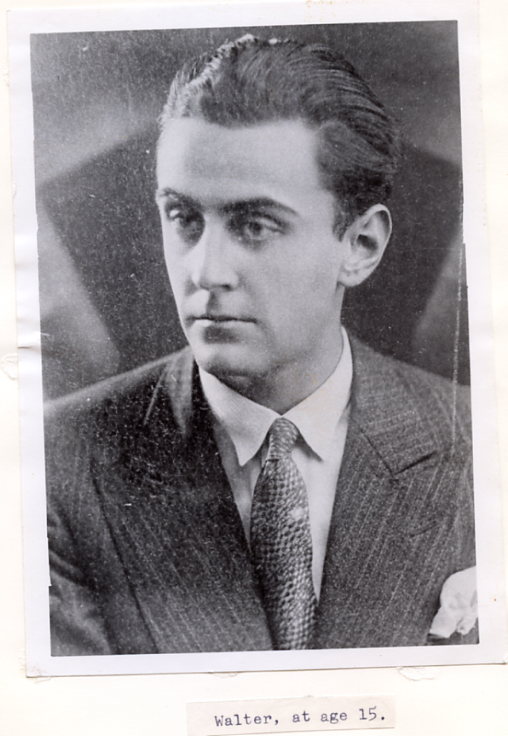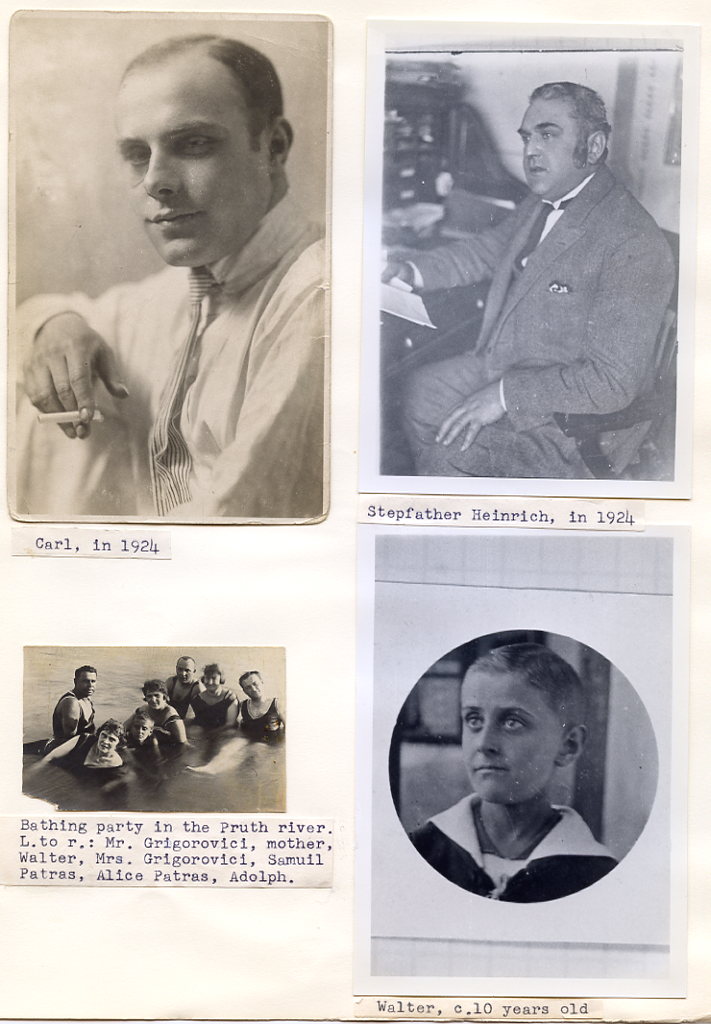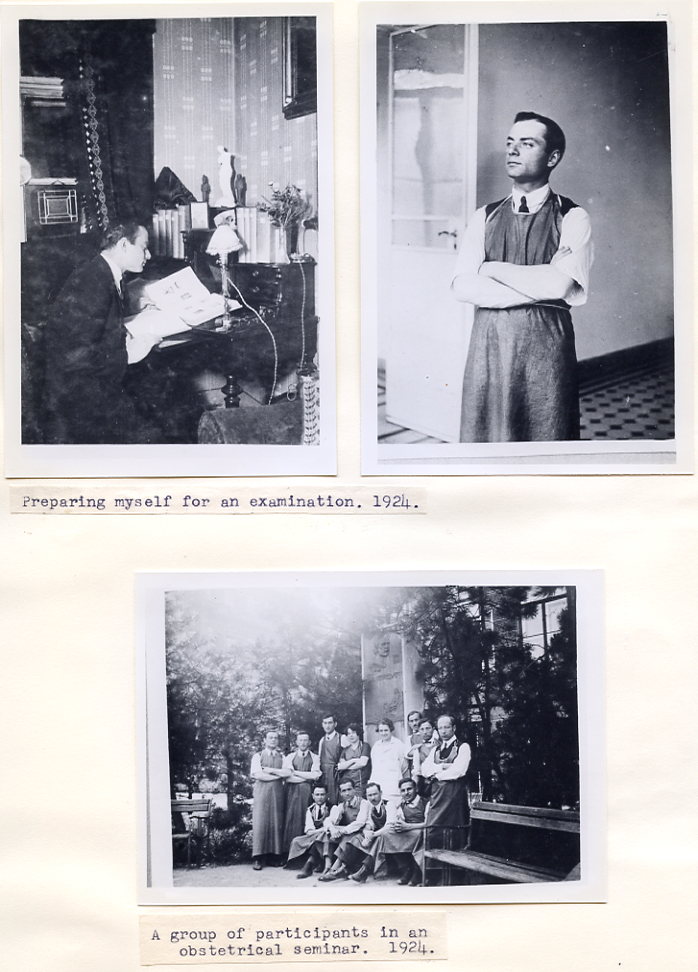1923
I have to go back now to 1922, when I returned to Vienna. The lectures which I now attended were all about clinical subjects, and I had to prepare myself for the examination of pathologic anatomy, a subject, which I liked very much. I had to attend lectures all day long, also take part in special courses in smaller groups, held by prominent pathologists like Carl Sternberg, Erdheim, and others. The subject was enormous, almost limitless.
In the year 1923, on April 1st, we made a big blunder. We thought, since it was spring, that it was the right time to make an excursion to the Rax, 6,000 feet high. We did not know that there was still deep winter there, and were not at all equipped for it, went in regular street shoes and light winter coats. We were six: My future father-in-law, Hedy, Lisa, Erich, myself, and a young man, a mister Fischel. We went really up to the top, where there were great numbers of skiers on the plateau, which was ideal for skiing. The sun was warm and some of the skiers had even taken off their shirts.
But with us it was a different story, because on the way up it was snowing a lot and we got quite wet. We were happy to get into the Fischerhuette and to get a warm meal. But we could not get rooms, only a so-called Matratzenlager (mattress bunk) and blankets. It was nice to be with all these sportsmen, at least 100 of them, in the dining room, where they all sang till late at night.
We had a miserable night, it was cold and we were wet. But we survived, and went down the next day to the railway station and home. I have 3 pictures of that trip, which show us in relatively good spirits.
.I signed up for the examination of pathologic anatomy for July 12th, 1923, and passed it with the mark “excellent.” Now I went again to Czernowitz for a nice vacation. Carl was already married and working as a partner in the mineral water company, and my family and the family Ohrlaender had formed a very friendly relationship. My stepfather and Carl’s father-in-law had formed, together with some other friends, a group, which took to hiking and went every Sunday on trips, sometimes joined by the women, and I joined them too. I have a number of pictures, which show us on such excursions. In one we were eight, standing in a row. Lotte’s father was a very fine, pleasant person, and Lotte was very pretty. Two pictures show us in our living room, in one of which one can see some of the furniture, which my father had made in his factory, some 30 years before. In one there is Lotte playing the piano, and Carl is singing, showing off with a wide open mouth and one arm raised high up, apparently trying to reach the high C. Walter is also in the picture, a very handsome boy.
That was the last time that I visited Czernowitz, in the summer of 1923, more than 50 years ago, I did not know, when I left, that it would be the last time that I saw the city and the house in which I had lived for so many years, happy years of my childhood and later, though only sporadically and for short periods, during my young adulthood. I was often thinking back later on, wishing I had a picture of that house. And now, 50 years later, Carl sent me 2 pictures of that house, which were found among the papers of my sister Else. He made me really happy. I looked for a long time at these pictures, which produced feelings of melancholy, and I still look at them from time to time. The house does not exist anymore and, anyway, Czernowitz is now a minor city in Russia.
I have other pictures, taken in 1923 in Kritzendorf on the Danube, with big groups of young people in swimming suits, with Hedy, Lisa, Erich, also my future mother-in-law, her sister Suei, and their youngest brother Heini. These pictures must have been taken before I went on vacation. After my return to Vienna, I again studied hard and signed up for 4 examinations, starting with experimental pathology, which I took on November 8th, 1923, and passed with the mark “excellent,” and on the same day pharmacology, which I also passed with the mark “excellent.” Then came internal medicine on December 17th, which I passed with the mark “satisfactory” and pediatrics on December 22th, which I passed with the mark “satisfactory.”
Right afterwards, we went off with a ski club for Annaberg near Mariazell in the Austrian Alps. It was the first time we were on skis and it was quite hard, but we had good instructors. We were a nice group of about 80 people. The lanes were not too steep and the snow firm and just right for learning. This club used and instructed us in the so-called Lilienfelder technique, propagated by a Mr. Zdarski. It meant using one long stick with a metal point instead of the usual two sticks. It makes skiing much easier, and especially for beginners. The long stick is very useful as a kind of brake when the going is too fast and makes turning also easier. The technique never became popular and is now long forgotten. We never learned how to ski with 2 sticks.
We went out with the club shortly before Christmas, and spent nice evenings, when we sat together in the not too large dining room. Unfortunately, the weather was not favorable, it turned warm and the snow melted around the New Year. Nevertheless, we all stayed on for a few more days as planned, and finally returned to Vienna. Later this same winter, we went with a small group again on ski tours. In one picture we are grouped around a big snowman, which we had built, who had a pair of skis under his arm. A few times, Hedy and I went alone on ski tours, among others in the Semmering area.
Sometimes Hedy visited me in my room in the Belvederegasse. We did together some ceramic work, which we enjoyed very much. I got some clay from a nearby company, which specialized in ceramic stoves and had big kilns. We formed ashtrays, flower pots, vases, etc, often in the shape of flowers, and took our work then to the ceramic company, where they put our pieces into the kiln, and then also glazed them for us in the colors which we chose. Once we made a bird, modeled after a stuffed blue jay, which I had brought many years before from Czernowitz. It was our most beautiful piece of art, and we have it in one of the last pictures of my in-laws, standing on top of a fireplace.
One more examination of psychiatry on March 3rd, 1924, and I was through with the 2nd rigorosum. This one examination was a repeat. I had taken it 2 or 3 weeks before and had failed, but the second time I passed it. The examiner was the famous Nobel Laureate Wagner-Jauregg.
Shortly before we had a sad experience. It was on or about February 23rd, 1924. that I received a telephone call from Czernowitz and was told that my stepfather was seriously ill with yellow jaundice, and that he and my mother will take the next train for Vienna and that I should make a reservation for a bed in a hospital. They both arrived the next day and I brought them from the railway station to the clinic Eiselsberg, the best surgical clinic in Vienna. He had severe jaundice and it was clear that it must have been a cancer with obstruction of the main bile duct. He was operated on by a fine surgeon, who found a tumor of the pancreas and all he could do was to connect the gallbladder with the stomach in order to free the flow of bile, and also to make a connection of the stomach with a loop of the small intestines.
The next day, when I visited him with my mother, he was in a very weak condition. Intravenous feeding was not known in those days. And when we came again the next following day, on the 27th of February early in the morning, he was dead and his bed was empty. I had the opportunity to talk with professor Erdheim, whom I knew very well, who had just finished the autopsy, and he told me that it was a large cancer of the pancreas, which had obstructed the bile duct.
We returned very sadly to Else’s apartment, where my mother had stayed. We made arrangements for a short ceremony at the cemetery and also for a cremation of the body. My poor mother stayed a few days more with us, and then returned with the urn in her baggage to Czernowitz. She was now a second time a widow. Little Walter was only 12 years old. How good was it, that Carl was there and could continue with the business, otherwise everything would have been lost.
The next two examinations I took in a rather rapid succession, dermatology on March 24th, 1924, with the mark “satisfactory” and ophthalmology on May 22nd with the mark “satisfactory” also.
At about the beginning of June 1924 we went on an excursion to the Rax. It meant taking the train to Payerbach and then walking. There was no cable car yet in those days. As far as I remember, we took the so-called Schlangenweg (snake walk), which was the least steep but longest ascending route, and took us to the Kronprinz Rudolf Haus. We were five, Hedy, Lisa, Erich, a Mr.Aberbach, and myself. We wanted to go after lunch to the Otto Haua, walking on the plateau. But, there was a shorter route, the Bismarck Steig, which Hedy and I decided to take, along a very steep wall. There was at the start a warning sign that the Bismarck Steig was not safe before June. But we disregarded the warning and went on. We had to hold on to a strong metal rope, held in place by strong metal arms, driven into the rock, and for the feet there were also strong metal arms in the wall.
It was fun in the beginning and we advanced rather fast. Things became difficult, when a few people came in the opposite direction, as we had to move around another person or the other person around us. The wall was a vertical drop of 2,000 or 3,000 feet. But then, there was a dilemma. The rope was covered by a snow field, about 20-feet wide and that meant that we had to cross that field at an angle of about 45 degrees, with nothing to hold on, except our canes. It was frightening and we decided not to walk over the snow, which was firm, but rather around the lower edge, where there was a field of loose rocks. It was a dangerous thing to do that.
Hedy was a little ahead of me and went well across the field of rocks. But when I followed her, the whole field of rocks started to move, and I too. I saw the end of my life, because 8 or 10 feet down there was the end and the steep wall again. I grabbed my cane with both hands and sunk it vertically into the stones, and miraculously stopped the movement of the field of rocks. I had yelled when it happened, but Hedy had not heard it. Using the cane, I went over to Hedy and had again firm ground under my feet.
But the next moment, something terrible happened. Two young men, coming in the opposite direction, were crossing the snow field, one man walking in front and loosening the snow with an icebreaker for the other man. I had seen him doing it. But that man lost his halt on the snow and rock field before our eyes and came sliding down with great speed and disappeared in the depth. Hedy and I thought we would lose our minds. But there was nothing we could do. We saw people far down on the Schlangenweg looking up, seeing that man fall. Soon afterwards a rescue expedition arrived and they went down with strong ropes. But that man was dead, and we read about him the next day in the newspapers.
We met our people at the Ottohaus and told them the story.
On the way down from the Ottohaus I had a mishap. I tripped over a stone and injured a ligament of an ankle. It swelled up and I could only walk the rest of the way with my arms around the shoulders of Lisa and the other young man. We advanced slowly and reached the railway station in Payerbach, where we had to wait for the train back to Vienna. Coming home, I went right away to bed and applied cold dressings to my foot.
The next day, I could not walk, and what was very bad about that was that I was supposed to start on that Monday my seminar at the department of gynecology and obstetrics. I called them up and told them about my mishap. They told me that it would not matter if I missed one day, and that I should try to come the next day. Bed rest helped and I was much better the next following day and I went there to start the seminar. We were 10 or 11 students, of whom I have 3 pictures in my album, who had to live for one week or may be 10 days in the institute and participate in examinations of pregnant women and observation, when they gave birth. We were often called during the night and had to rush to the delivery room to see the process of childbirth. I took my examination of gynecology and obstetrics on July 18th, 1924, and passed it with the mark “satisfactory.”
For my next summer vacation I did not plan to go to Czernowitz. Another rare opportunity came up. Two cousins of Hedy, Hella Ziegler and her sister Marianne, had planned to spend their vacation in Vorarlberg in Gargellen, a small village deep in the Alps, and encouraged us to spend the last 10 days or two weeks there with them. We happily accepted and were soon on our way, took a night train, hardly slept and arrived very early in the morning in Schruns. From there we had to walk about 15 miles to Gargellen. There was no bus. We were tired and very hungry and hoped to get somewhere a cup of coffee. In Schruns there was only one inn, which we saw from far away, and when we arrived there, there was a sign on the house which said: “Entrance forbidden to Jews and dogs.” We didn’t believe our eyes. We had heard about such signs in Germany, where the antisemitism was developing rapidly, but that was 1924 and long before Hitler, and it was in Austria. We couldn’t do anything, there was no village between Schruns and Gargellen and we had to continue walking, with our hungry stomachs on a rather steep road. As we advanced on the road, a wonderful world of mountains came into view, a landscape we had never seen anything like it before. To the west the Raeticon mountain group appeared in all her majesty, to the south the Madrisa group, and to the east the Ritzerispitzen. It was a splendour which let us forget our hunger and tiredness. It took us about 5 hours till we arrived in the beautiful hotel Madrisa in Gargellen, joyfully expected by Hedy’s two cousins, and just at the right time for lunch.
The next 8 or 10 days we spent there with them were a real pleasure and we enjoyed the many walks through the meadows full of beautiful flowers, the like of which we had never seen before, like the chocolate flower, which really had the color and scent of chocolate, different varieties of gentian, arnica, and many others. Sometimes Hedy and I went on smaller excursions without the cousins. After all, we were young and in love, and the cousins were very sympathetic.
Once I was called to see a patient, and although I was not yet a doctor, I went there. I don’t remember anymore what kind of case it was. Some chronic disease, which kept the woman in bed for a long time. It could have been a case of tuberculosis. After more than 50 years it is difficult to remember that. Anyway I gave her some advice, and to my astonishment she insisted on paying me a fee and I had to take it. It was the first money I made in my medical career.
Once Hedy and I went on a bigger tour and this experience we remember too well, since we had told the story many times. We went one day over the border to Switzerland and that was a risky undertaking, since we did not have passports, and we were told that people who were caught were put in jail. The day before, we managed to get some Swiss money. The next day, we started out very early and went the steep road up to the Schlappiner Joch, which means a passage between mountains, and that was the border. We went then down on the Swiss side, also quite a steep road and came to the village Schlappin. The houses appeared empty, not a soul was visible. We understood that all folks were up on the pasture grounds in summer. Another hour or so of walking downhill and the town of Klosters came into view. The railroad station was right there at the end of our road.
We had planned to go to Davos, to see that famous place. We asked for 2 tickets, but it turned out that we did not have enough Swiss money. What we had was sufficient to go to St. Wolfgang. A look at the map showed us that it was only a few miles from there to Davos-Dorf, and so we took the tickets to St. Wolfgang, and soon the train came. We got out in St. Wolfgang and walked then to Davos, hoping to find there a bank to change our Austrian money. We found a bank, but it was closed at noon and opened at 2 P.M. Across the street was a nice coffeehouse and we went there and ordered among other things chocolate. It was the best we ever drank and a big pitcher full. We waited there till the bank opened and changed enough money to pay for the lunch and for the return trip to Klosters. We had time to walk around and also to Lake Davos. We then took the train to Klosters. It was already late in the afternoon, when we arrived there. We looked around carefully, and to our dismay saw a gendarm, who was standing with his rifle in the midst of the road, which we were supposed to take up to the Schlappiner Joch. It was a terrible problem. We kept watching the gendarm, but he did not move.
The road was narrow, with steep lanes on both sides. But I noticed that there was a kind of furrow behind him and parallel to the road. The furrow ended about 100 yards above the place, where he stood and joined there the road. It was not deep, but we saw that if we bent down, he could not see us. So we went rapidly to that furrow and walked up, very carefully not to make any noise, all the time bent down. When we passed behind him, we were only about 15 feet away from him. When we reached the end of the furrow, we had to get out and run on the road. Looking back, we saw him running too. We thought he would shoot, but he did not. He had no reason, since we were only running and in the direction of the border of Switzerland, and his duty was only to watch that nobody should enter the country over the mountain pass. We lost sight of him and kept running. It was terribly strenuous to run uphill for at least half an hour, till we reached Schlepping.
There we went behind a house and sat down on a bench, or rather collapsed. We had still some food in our rucksack and ate it, boiled eggs and bread or whatever it was. Then we had to start walking again, it was late and we did not want to walk in the dark. So, we reached the Schlappiner Joch and went as fast as we could the last few miles to the hotel, arrived there when it was already dark. That was quite a trip! In hindsight a stupid thing to do. Young people do such things.
Another exciting experience was a trip which I made with a man who was a guest in the same hotel in Gargellen. He had asked me the day before whether I would like to go with him on a mountain climbing tour the next day, and I immediately agreed. We started early in the morning and our aim was the Madrisa Horn, which was close to the Madrisa Spitze, but a little less high. The exact height I don’t know anymore, but I assume that it was about 6,500 feet. We ascended in the direction of the Schlappiner Joch, but then went south. He was an experienced alpinist, about 50 years old and well equipped for a climbing tour. He was a German, like most of the other guests in the Hotel Madrisa, and a very interesting man.
I remember that we were molested by flies, while we walked. The path became quite steep and exerting. When we reached a snowfield, I tried not to walk on the snow, but he was in front of me and the snow was firm and the incline not bad. But I still remembered the experience I had in the same year on the Rax and told him about it.
After crossing a large snow field, we came to a rocky edge of that field and stayed on it. There were difficult rocks to pass and that man gave in, came over to me and fastened the climbing rope around my waist and then also around his, and then went ahead of me. The climbing was quite arduous and we had to rest a few times. The final climb to the top of that mountain was quite steep, but we made it. There was a wooden cross at the top, held in place by a heap of large rocks. We had a wonderful view from there of many of the giants of the Austrian and Swiss Alps, the Ortler, the highest mountain in Austria, not far away, the Madrisa Spitze quite near, the Scesa Plana in the north, and in the southwest the Bernina group, the Jungfrau, and the Matterhorn. It was very windy there and we did not stay long. I took a picture there, and then we started to descend, which was in many places more difficult than the ascent, and reached the hotel In the late afternoon. It was a wonderful experience.
A few days later, we left the hotel with our cousins Hella and Marianne for good. Hedy and I had planned to continue our vacation on our own. Later on, when we were in Vienna, I offered the film of the snapshot I had taken of the Madrisa Horn to a postcard publishing house. There was no picture of the Madrisa Horn in existence. They offered me 25 Austrian Schillings and I accepted. I never saw the postcard, nor do I have any of the many pictures which I had taken on that vacation trip. All left in Vienna and lost. We said good-bye to our cousins and left, with the intention of climbing up to the Scesa Plana, 9,000 feet high.
I had a good map and we walked up all day long, till we reached a tourist house, where we got a room and a good meal. It was full of tourists. We were very tired and went soon to bed. Early in the morning, around 4 o’clock, we were awakened by the noise of many people, walking with their heavy mountain shoes on the wooden floors and stairs. I went out to ask why they had gotten up that early, and I was told that all of them wanted to be up on the Scesa Plana in time to see the wonderful spectacle of the sunrise. We wanted to see that too, of course, and were soon dressed and on our way, following other people, since it was still dark, and arrived at the top of the Scesa Plana in time to see the wonderful spectacle of the sunrise.
There were great many people up there, also many who had come from the Swiss side, since the Scesa Plana and the Rhaeticon group form the border between Austria and Switzerland. The young Swiss people spoke the Swiss German, of which we didn’t understand a single word. It was wonderful to see all the high mountains tinged red. We had a special map, which showed the silhouette of the Alps, as seen from the Scesa Plana, and could distinguish all the giants up to the Mont Blanc. We stayed quite a few hours there, enjoying the view and the air. There was also a glacier there, and we saw a few chamois, a relative of the goat, crossing the glacier. Looking down into Switzerland, we saw the city of Chur. I forgot to mention the mormots, which we often saw, rodents which are relatives of the squirrels, but much bigger and without the long tail. They live in the high mountain areas in holes, and there is always one of them watching and whistles, when somebody comes into its view, and all of them disappear in their holes. But a few times we managed to see them roaming around, when we were very careful when reaching a rim and looking over it, before they could see us.
Coming down, we went again into the tourist house for a meal and then on to Bludenz, where we took a train going west to Bregenz, to take a look at the Bodensee. It was wasted time and money, since the Bodensee didn’t look different from other lakes. We then went back eastward to Innsbruck, which we had not seen before and stayed one day. This time it was not wasted time and money, as Innsbruck is a beautiful city. Then on to Vienna, where we had a lot to tell about this most beautiful trip, which we had enjoyed enormously.
Soon I had to return to my books to prepare myself for the last three examinations. The first one was of legal medicine, which I took on. November 6th, 1924, and passed with the mark “satisfactory,, the next one was of hygiene on November 7th, 1924, which I passed with the mark “excellent,” and the last one of surgery on December 5th, which I passed with the mark “satisfactory.” This one was also a repeat examination, having failed about two weeks before, when I had the misfortune of cutting one of my fingers while performing an amputation of the forefoot on a cadaver, when the knife slipped in my hand. I therefore had to repeat the examination and passed it. This was the last examination of the 3rd rigorosum.
